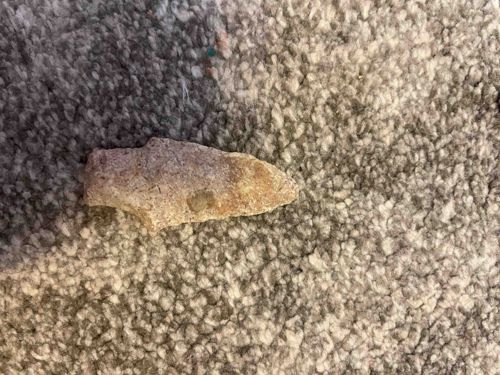
Stone Projectile Point Fragment
The item appears to be a lithic artifact, likely a projectile point fragment or a tool preform, made from a light-colored, granular stone, possibly chert, flint, or a fine-grained quartzite. Its color ranges from a pale beige or off-white to light brown, with some areas exhibiting a subtle reddish or orange tint, suggesting mineral inclusions or surface patination. The texture seems somewhat porous or weathered, indicating exposure to natural elements over a long period. In terms of physical characteristics, it is elongated and roughly triangular or leaf-shaped, tapering to a somewhat blunted point on one end, and having a fractured or incomplete base on the opposing end. The visible edges show signs of flaking, characteristic of knapped stone tools, though the resolution does not permit a clear assessment of specific flaking patterns like parallel or random percussion. There are no clear indications of fine retouch or pressure flaking that would typically define a finished arrowhead or spear point. One observable circular inclusion or 'eye' is present, slightly darker than the surrounding material. The overall condition suggests significant age; there are no clear signs of modern damage or repairs, but the natural wear and erosion contribute to its aged patina. The piece is relatively small, consistent with a personal hand tool or projectile tip. Given its material and apparent manufacturing technique (flintknapping), it falls into a prehistoric or early historic period style from cultures that utilized stone tools. The craftsmanship, while appearing rudimentary at this fragment stage, suggests intentional shaping rather than a naturally occurring rock, implying human modification and usage.
AI-Generated Appraisal Disclaimer
Estimated Value
$40-70
Basic Information
Category
Archaeological Artifact/Tool
Appraised On
November 28, 2025
Estimated Value
$40-70
Item Description
The item appears to be a lithic artifact, likely a projectile point fragment or a tool preform, made from a light-colored, granular stone, possibly chert, flint, or a fine-grained quartzite. Its color ranges from a pale beige or off-white to light brown, with some areas exhibiting a subtle reddish or orange tint, suggesting mineral inclusions or surface patination. The texture seems somewhat porous or weathered, indicating exposure to natural elements over a long period. In terms of physical characteristics, it is elongated and roughly triangular or leaf-shaped, tapering to a somewhat blunted point on one end, and having a fractured or incomplete base on the opposing end. The visible edges show signs of flaking, characteristic of knapped stone tools, though the resolution does not permit a clear assessment of specific flaking patterns like parallel or random percussion. There are no clear indications of fine retouch or pressure flaking that would typically define a finished arrowhead or spear point. One observable circular inclusion or 'eye' is present, slightly darker than the surrounding material. The overall condition suggests significant age; there are no clear signs of modern damage or repairs, but the natural wear and erosion contribute to its aged patina. The piece is relatively small, consistent with a personal hand tool or projectile tip. Given its material and apparent manufacturing technique (flintknapping), it falls into a prehistoric or early historic period style from cultures that utilized stone tools. The craftsmanship, while appearing rudimentary at this fragment stage, suggests intentional shaping rather than a naturally occurring rock, implying human modification and usage.
Get Your Items Appraised
Instant estimates of your treasures with AI-powered instant appraisals